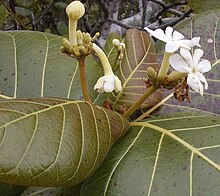Guettarda speciosa
| Guettarda speciosa | |
|---|---|
 |
|
| Scientific classification | |
| Kingdom: | Plantae |
| (unranked): | Angiosperms |
| (unranked): | Eudicots |
| (unranked): | Asterids |
| Order: | Gentianales |
| Family: | Rubiaceae |
| Genus: | Guettarda |
| Species: | G. speciosa |
| Binomial name | |
|
Guettarda speciosa L. |
|
Guettarda speciosa, with common names beach gardenia,sea randa, or zebra wood, is a species of shrub in the family Rubiaceae found in coastal habitats in tropical areas around the Pacific Ocean, including the coastline of central and northern Queensland and Northern Territory in Australia, and Pacific Islands, including Micronesia, French Polynesia and Fiji, Malaysia and Indonesia and the east coast of Africa. It reaches 6 m in height, has fragrant white flowers, and large green prominently-veined leaves. It grows in sand above the high tide mark.
Alternate names in the Cook Islands include 'Ano, Hano, Fano, and Puapua. The last is also used in Samoa, and the similar Puopua in Tonga. It is known as Utilomar in the Marshall Islands.
It was originally described by Carl Linnaeus. The genus was named in honour of the 18th century French naturalist Jean-Étienne Guettard, while the specific epithet is derived from the Latin speciosus 'showy'.
It is a perennial shrub or small tree 2–6 m (6.6–19.7 ft) tall by 1–3 m (3.3–9.8 ft) wide with smooth creamy grey bark. The large oval-shaped leaves are 15–23 cm (6–9 in) long by 10–18 cm (4–7 in) wide. Dark green and smooth above with prominent paler veins, they are finely hairy underneath. Flowering is from October to May, the fragrant white flowers are 2.5–3 cm (1–1 1⁄4 in) long with 4–9 lobes. These are followed by sweet-smelling globular hard fruit, measuring 2.5 cm–2.8 cm × 2.2 cm–2.5 cm (0.98 in–1.10 in × 0.87 in–0.98 in), which mature September to March.
Guettarda speciosa is found in coastal habitats in tropical areas around the Pacific Ocean, including the coastline of central and northern Queensland and Northern Territory in Australia, and Pacific Islands, including Micronesia, French Polynesia and Fiji, Malaysia and Indonesia and the east coast of Africa. As its name suggests, the beach gardenia grows on beaches and sandy places above the high tide level.
The Mariana Fruit Bat (Pteropus mariannus) feeds on the fruit and flowers, acting as a vector for the dispersal of seeds.
...
Wikipedia
